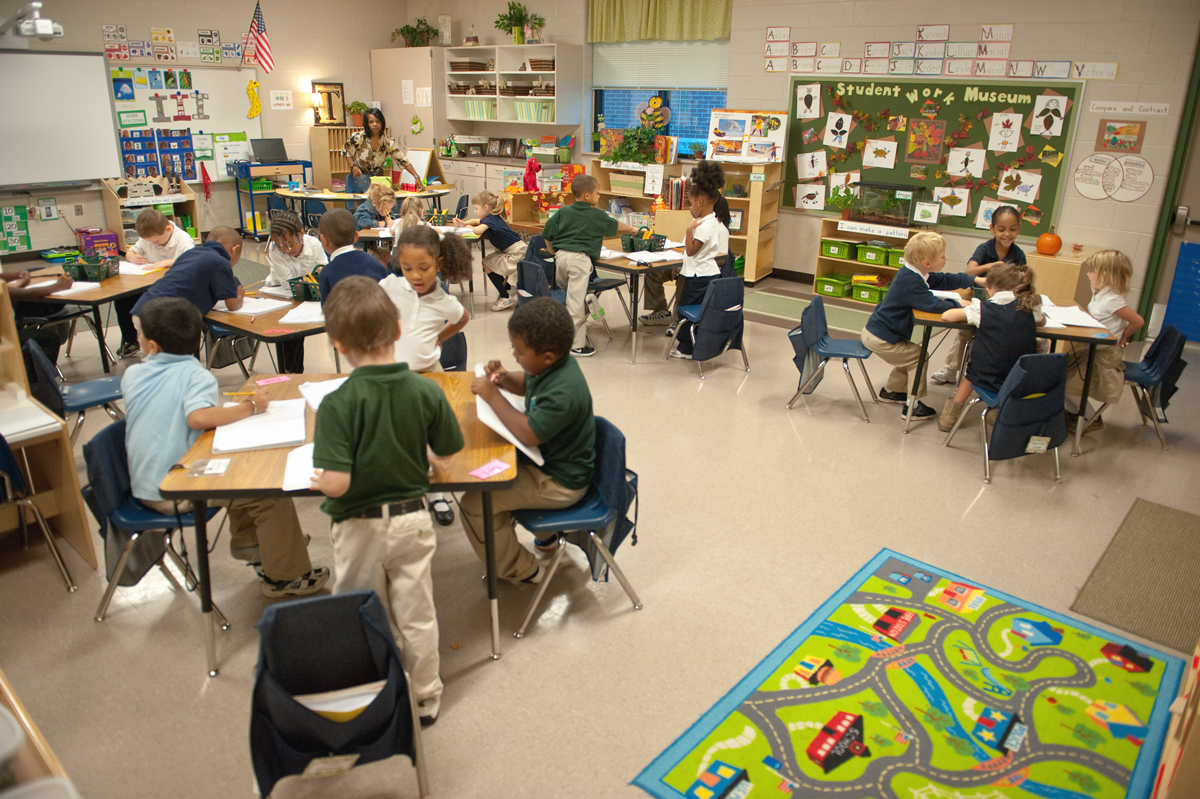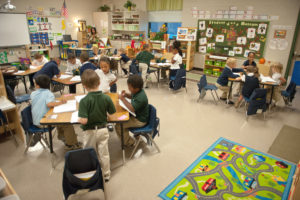A Quiet Place for Rough Moments

 Alison, a young five-year-old I taught recently, struggled with separation anxiety at the beginning of the year. She had a hard time saying goodbye to her dad when he dropped her off in the mornings. On one particularly difficult day, she went through all the usual routines—blowing a kiss, waving goodbye at the window, drawing a picture for her dad—but was still distressed.
Alison, a young five-year-old I taught recently, struggled with separation anxiety at the beginning of the year. She had a hard time saying goodbye to her dad when he dropped her off in the mornings. On one particularly difficult day, she went through all the usual routines—blowing a kiss, waving goodbye at the window, drawing a picture for her dad—but was still distressed.
Though upset, Alison knew what to do. She grabbed her stuffed animal and made a beeline to the quiet place. After ten minutes of cuddling with her stuffy and looking at a book, she joined the group, happily and on her own. Not that Alison wasn’t sad the next day when her dad left, but she had a way to help herself feel better.
Based on ideas in Jane Nelsen’s book Positive Discipline in the Classroom, the quiet place is a space in my classroom where children can go voluntarily to comfort themselves. The quiet place is different from the time-out space: in my classroom these are two separate places with different purposes.
I introduce the quiet place in the first week of school, before we launch into academics, before we learn to use classroom materials, before we even begin thinking about our hopes and dreams for school or what our classroom rules should be.
During this week I introduce basic classroom routines such as responding to the quiet signal, raising a hand to speak during meetings, circling up, and walking in a line down the hall. Just as these classroom routines provide a sense of order and security, the quiet place reassures children that their personal emotional needs will be taken care of. With this reassurance, children will be free to think about the needs of others and able to open their minds to learning.
Introducing the quiet place
I begin by talking with the children about times when we’re too sad or upset to think. I tell them that everyone feels that way sometimes and that by taking some time alone, we can help ourselves feel better. Then, when we feel better, I say, we’ll make better decisions about taking care of ourselves and others.
Young children tend to like enclosed, private spaces. I prepare such a space ahead of time. But now the children and I think together about its contents. If the purpose of the quiet place is to help us feel better, what might we put there? Pillows, stuffed animals, books, and drawing materials are usually the first things children mention. After gathering some of the materials the children name, I ask them to help arrange the items in the space.
Teaching when and how to use the quiet place
Although I sometimes suggest that a student go to the quiet place (I never tell or insist that a student go), my goal is for students themselves to know when it would benefit them to go.
So, once the quiet place is set up, we talk about some specific reasons why someone might use it. The typical causes of distress for children may differ depending on their age.
“You might feel sad because you miss your mom,” a new kindergartner might say.
“You might be upset because someone cheated at checkers,” a first grader might say.
A typical seven-year-old’s response might be, “You might feel mad because someone wouldn’t sit with you at lunch.”
And an eight-year-old might suggest, “You might feel angry because you couldn’t play kickball at recess.”
Next, we talk about how to go to the quiet place, how to be in it, and how to come back, all without disturbing others in the class. We name specific actions: walk in a normal, calm way; keep our hands to ourselves when we walk to the spot and back; keep our mouths quiet or only humming softly while we’re there; and so forth.
But talking isn’t enough. Children also need to see what these expected behaviors look like and experience what they feel like. So after we’ve named the behaviors, we model them. First I demonstrate going to the quiet place, staying there a while, and coming back. Then I let the students demonstrate. I allow plenty of time so that everyone who wants to demonstrate can do so. Because children will be using the space when they’re upset, this rehearsing is especially important. (See the article “Bringing Classroom Rules to Life” for more about modeling.)
Additional tips for effective use
Get clear on what you will and won’t allow in the space.
It’s important to let the children help create the quiet place. At the same time, for safety and other reasons, the teacher needs to set some limits. For example, I don’t allow smooth rocks (even though some children find them soothing to touch) because they can be thrown. I don’t allow music because children too easily get absorbed in the music and forget to come back. One year, students wanted to use our reading corner for the quiet place. I vetoed that because it was important to preserve a nice space for reading.
Teach children how long to stay in the quiet place.
I tell them to stay “until you feel calm” or “until you feel you can take care of your problem.” This usually translates to a five- to ten-minute stay.
Make sure children don’t use the quiet place to avoid doing something.
Some children may use it to avoid doing a hard assignment, working with a certain partner, or sitting through a meeting. In these cases, I never tell children they can’t go to the quiet place. I do tell them they’ll have to make up the work they missed, perhaps during recess or choice time. Usually, the children feel better very quickly and return to the task at hand.
Watch for children who are very reluctant to use the space.
Occasionally when I suggest that a child use the quiet place, the child will absolutely refuse or will only go if I go with him/her. There are many possible reasons for this. Whatever the reason, I know it will take longer for these children to learn to comfort themselves. To help them along in the process, I come up with some interim steps, such as bringing a comfort item to their seat or coming to sit next to me when they’re upset.
Have a plan in place for children who are too upset to use the quiet place.
Sometimes a child is too distressed to use the quiet place: the child might need one-on-one attention from an adult or might not be able to use the quiet place without disturbing other children. In this case, it’s important to have another plan that provides for the child’s safety and minimizes disruption to the rest of the class.
The ultimate goal: helping children find the quiet place within
As the year goes on and children become more adept at using the quiet place, I begin to see them managing their feelings in the moment without needing the physical space.
Surprisingly, this is often true for some of the most strong-willed children. Louisa was an energetic, highly determined six-year-old who hated to lose. She argued when she was tagged and cried when she couldn’t be first. Early in the year, after losing a game and at my suggestion, Louisa would go to the quiet place just as she was about to have a tantrum. She’d snuggle, she’d cry quietly, she’d brood. Then she’d come back to join the group when she felt better.
By the middle of the year, when Louisa lost a game, I often saw her manage her feelings without needing to remove herself physically from the group. Instead, she would separate herself emotionally for a moment. She would bow her head, clench her fists, pull her knees up to her chin. A minute later, she would be recovered and ready to play again.
Teaching children how to keep themselves in control in emotionally charged situations will help them enormously throughout their schooling and lives. In the case of Louisa, one of her strengths was that she cared so deeply about things. The quiet place helped her develop the inner control that would allow her to use her strong emotions effectively without erasing them.
Teachers need a repertoire of tools and techniques to help our Louisas, Alisons, and all students learn self-care, self-control, and self-discipline. The quiet place can be one important element in a repertoire for young children.
Deborah Porter is a primary grades teacher at the Heath School in Heath, Massachusetts. She has twenty-eight years of teaching experience at the primary and preschool levels and has led Responsive Classroom workshops for the past sixteen years. She is co-author of Rules in School.
